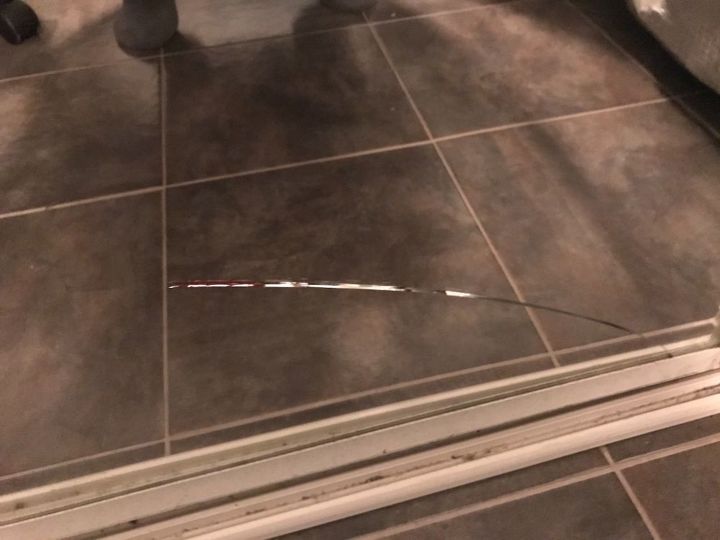Mirrors, essential fixtures adorning homes and commercial establishments alike, bring beauty and functionality to our spaces. However, unforeseen accidents or environmental factors can lead to the unfortunate occurrence of cracks marring their pristine surfaces. While cracked mirrors can be a cause for concern and a potential safety hazard, it’s not always necessary to discard them immediately. With the right knowledge and techniques, you can save your beloved mirrors and restore them to their former glory. In this comprehensive guide, we delve into the realm of mirror repair, empowering you with the expertise to fix cracked mirrors and breathe new life into your reflective décor.

Image: www.wikihow.com
Understanding Mirror Damage: Types and Causes
Mirrors are typically made of glass, a fragile material susceptible to various types of damage. Cracks, one of the most common forms of mirror damage, can range in severity from superficial hairline fissures to deeper, more extensive fractures. Understanding the different types of cracks is crucial for determining the appropriate repair strategy.
-
Superficial cracks:
These hairline cracks are often caused by minor impacts or thermal stress. They may not significantly impair the mirror’s functionality or pose a safety hazard but can still be unsightly.
-
Edge cracks:
As the name suggests, these cracks originate at the mirror’s edge. They often occur due to uneven pressure or improper mounting. While less common than other types, edge cracks can compromise the mirror’s structural integrity over time.
-

Image: www.hometalk.comRadial cracks:
Also known as “spiderweb cracks,” these cracks emanate from a central point of impact. Unlike superficial cracks, they can significantly weaken the mirror and create sharp edges that pose a safety risk.
-
Star cracks:
Resembling starbursts, these cracks result from direct, concentrated force. They can severely compromise the mirror’s integrity and render it unusable.
Assessing Mirror Damage
Before embarking on the repair process, it’s essential to assess the severity of the damage. This will determine the feasibility of repair and the appropriate technique to employ.
-
Safety first:
If the mirror is shattered or has large, jagged cracks, prioritize safety. Wear protective gear like gloves and safety glasses to prevent injury.
-
Inspect the crack:
Determine the type of crack and its size. Observe if the crack extends to the mirror’s reflective coating.
-
Check for stability:
Assess if the cracked area is loose or unstable. Loose shards can pose a hazard and should be handled with extreme caution.
Tools and Materials for Mirror Repair
Once you’ve evaluated the damage, gather the necessary tools and materials to initiate the repair.
-
Glass repair kit:
This comprehensive kit typically includes a specialized resin, adhesive, and polishing compound.
-
Safety gear:
Gloves, safety glasses, and a dust mask are essential for protection.
-
Cleaning supplies:
Isopropyl alcohol, cotton balls, and a lint-free cloth are needed for cleaning the repair area.
-
Measuring tape or ruler:
For measuring and estimating the extent of damage.
-
Toothpicks or artist’s brush:
For applying the resin precisely.
-
UV lamp (optional):
While not necessary, a UV lamp can accelerate the curing process of the resin.
Step-by-Step Mirror Repair Guide
With the necessary tools in hand, follow these step-by-step instructions to repair the cracked mirror:
-
Safety precautions:
Ensure you have a clean and well-ventilated workspace. Wear safety gear and handle the mirror with care.
-
Clean the crack:
Use isopropyl alcohol and cotton balls to thoroughly clean the crack and its surrounding area. Remove any dirt, oil, or debris that may interfere with adhesion.
-
Prepare the resin:
Mix the resin according to the manufacturer’s instructions. Ensure the ratio of resin to hardener is precise for an optimal bond.
-
Apply the resin:
Using a toothpick or artist’s brush, carefully apply the resin to the crack. Fill the crack completely, ensuring there are no gaps or air bubbles.
-
Cure the resin:
Allow the resin to cure and solidify thoroughly. Most resins require several hours to cure at room temperature or can be accelerated using a UV lamp. Refer to the manufacturer’s instructions for specific curing times.
-
Polish the surface:
Once the resin has cured, use the polishing compound to smooth the repaired area and restore its transparency. Apply the compound with a lint-free cloth using gentle circular motions.
-
Final cleaning:
Wipe down the repaired area and surrounding mirror surface with a clean cloth to remove any residual polish or debris.
Additional Tips for Repairing Cracked Mirrors
-
Small cracks:
For superficial hairline cracks, you can use clear nail polish or superglue as a quick fix. Apply a small amount to the crack and allow it to dry completely. While not as durable as glass repair resin, it can provide a temporary solution for less severe cracks.
-
Large cracks:
If the crack is extensive or has compromised the mirror’s stability, it may be more practical to replace the mirror entirely. Consult with a glass professional for safe removal and installation of a new mirror.
-
Prevention is key:
To prevent future cracks, handle mirrors with care and avoid placing them in areas prone to impact or extreme temperature fluctuations.
How To Fix Cracks In Mirrors
Conclusion: The Art and Science of Mirror Repair
Repairing cracked mirrors is a combination of art and science. By understanding the different types of cracks, assessing the damage, and using the right tools and techniques, you can restore your mirrors to their original beauty and functionality. Remember to prioritize safety and handle the mirror with care throughout the process. With the knowledge and skills outlined in this guide, you’re empowered to tackle cracked mirror repairs with confidence, saving yourself the expense and hassle of mirror replacement.